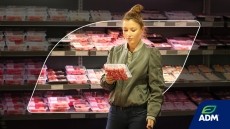FOOD FOR THOUGHT
From plant-based meat to plant-based….plants: What’s next after meat mimicry?

Gone are the days of searching at the back of the supermarket fridge for that one token meat substitute, rubbery and bland and quite possibly out-of-date.
Today, a dedicated plant-based section – if not a plant-based aisle – is now commonplace in retailers, carrying anything from meat-free burgers, sausages, mince, bacon, fish fingers, chicken fillets, and in the UK, even British pub classic toad in the hole.
According to recent research from Kerry Taste and Nutrition, demand for plant-based products continues to rise, with 42% of people choosing to go meat- and dairy-free on a ‘more regular basis’ compared to 2019 figures. Across Europe, the plant-based market is expected to reach a value of €18.3bn by 2023.
Considering the sharp rise in plant-based demand, I can’t help but wonder: what comes next? Does plant-based meat have staying power, or could the plant-based products of the future look and taste and smell like plants?
Making plants meaty
As demand for plant-based meat analogues develops, so too does innovation in the space.
The best-known example is undoubtedly US-headquartered Impossible Foods’ flagship offering, the Impossible Burger. After five years and a reported $80m (€72m) of research, in 2016 the company launched a meat-free patty that ‘bleeds’, thanks to a molecule known as heme. This ‘magic ingredient’ gives meat its slightly metallic flavour. It is also present in plants.
The Impossible Burger’s ingredients list includes soy protein concentrate, coconut oil, sunflower oil, potato protein, methylcellulose, yeast extract, salt, gums, and water. The burger also contains vitamin B12, zinc, vitamin B6, thiamine and niacin.
On this side of the pond, innovation continues apace. Nestlé is regularly improving on its Garden Gourmet Sensational Burger recipe – the latest iteration of which makes for ‘the meatiest plant-based flavour yet’ and a ‘juicier than ever texture’, according to the food giant.
Nestlé’s Sensational Burger also champions soy protein, as well as vegetable oils, vinegar spirits, flavourings, methylcellulose, plant concentrates (apple, beetroot, carrot, hibiscus), salt, and malt extract powder.
Both of these examples, and many others, are full of plant-based ingredients. Meatless Farm makes its products from pea protein, and Heura boosts its soy concentrate burger with an innovative fat analogue made from olive oil.
The point is that all these products do as their manufacturers intend: they look, taste, smell, and feel like meat. Which means that none of their plant-based ingredients look, taste, smell, or feel like plants.
On the upside…
Transforming plants into meat analogues is brilliant for a multitude of reasons. For starters, production of plant-based ingredients emits fewer greenhouse gas emissions, and requires less water and land than its meat-based counterparts.
And let’s not forget the animal welfare aspect. Despite its meat-like appearance, no animal died in the making of a plant-based sausage.
Another obvious advantage is that transitioning from a beef burger to a plant-based alternative that comes pretty darn close to mimicking beef’s look, texture, taste, and feel, isn’t a giant leap for consumers. No dramatic change in behaviour need take place. In fact, consumers may not even be able to tell the difference.
Ultimately, meat-free brands are giving consumers what they want: meat mimicry. The success of the plant-based market is evidence enough, as too is the rise in demand from consumers looking to cut down their meat intake.
And the down…
The situation is not all roses, however. While in the eyes of the consumer, the sector sports a ‘health halo’, plant-based analogues have been criticised for their ‘ultra-processed’ nature and nutritional credentials.
A 2020 survey commissioned by vegan alt meat maker Gosh! Food, and conducted by OnePoll, found that more than one-third of consumers believe plant-based products are ‘artisan’, rather than ‘highly processed’. A total of 38% believe plant-based products are only made from ‘recognisable’ ingredients one could find at home in the cupboard.
The survey also revealed that four in 10 shoppers believe plant-based foods only contain natural ingredients.
At the time, Gosh! Food marketing manager William Topp suggested consumers were ‘confused about the ingredients they eat daily’. The research also uncovered a ‘concerning’ lack of knowledge about common – and synthetic – ingredients used to deliver the taste or texture profile in plant-based foods.
Plant-based analogues have also been criticised for being ‘unhealthy’, particularly in regards to their salt content.
Last year, UK campaign group Action on Salt analysed 290 plant-based and vegan meals from 45 restaurant, takeaway, fast food and coffee chains. Findings revealed that three out of five plant-based restaurant meals surveyed with nutrition information contained 3g or more of salt – half of an adult’s maximum daily intake of salt.
Nineteen meals had 6g or more of salt, equating to an adult’s entire maximum daily limit in just one meal. At the time, Campaign Manager Sonia Pombo stressed it is important to know that a ‘plant-based’ or ‘vegan’ label does not automatically qualify a product as healthy.
It has been suggested that that the nutritional profile of meat and plant-based meat alternatives is different. A recent lab analysis undertaken by researchers at Duke University in the US indicated that near-meat and meat are not nutritionally equivalent.
“To consumers reading nutritional labels, they may appear nutritionally interchangeable,” said lead researcher Stephan van Vliet from the Duke Molecular Physiology Institute. “But if you peek behind the curtain using metabolomics and look at expanded nutritional profiles, we found that there are large differences between meat and a plant-based meat alternative.”
This research speaks to me. When I look back-of-pack on a plant-based burger, I immediately look for protein content. If it’s comparable to that found in a conventional meat product, there’s much more chance it will end up in the shopping basket.
I’m guilty of perceiving such products as nutritionally interchangeable, and doubt I’m the only one.
Crystal ball gazing
There is still room to move within the meat analogue space. Brands are nailing meat mimicry in so many ways – if nutrition and ingredients lists can catch up across the board, there will be even fewer reason for Europeans to avoid reducing their meat intake.
I wonder if this is where we’ll stay in plant-based, however. Forever mimicking meat. Or could innovators steer the plant-based movement in another direction? Gazing into a crystal ball, would it be so bad if in the future we let plants taste, look, smell and feel like plants?
Perhaps we’re headed for a meat analogue whiplash effect, whereby consumers seek minimally processed, ‘natural’ ingredients, in products that aren’t pretending to be anything they’re not.
Earlier this year, Annika Boström-Kumlin, Chief Marketing Officer at Finnish plant-based manufacturer Beanit, told a FoodNavigator panel that meat analogues have their place: they attract more consumers to the plant-based sector. This is impossible to disagree with.
But in the future, she predicts new types of plant-based foods will enter the market. For Boström-Kumlin, these products ‘won’t necessarily mimic meat’. Rather, they will ‘stand on their own feet’ and bring ‘vegetarian options to the table’, without copying the sensory properties of beef, chicken, lamb, or even toad in the hole.
During the same panel, Stefan Uhlmann, Head of Cereals, Business Unit Cereals, Nuts and Pulses at Döhler agreed that NPD will change direction. “Over the last couple of years…mimicking has been the main strategy. Mimicking milk, mimicking minced beef, and so on. But now the audience and target [market] is so big, it is time for plant-based to [move on] from mimicking to create its own category.”
Ultimately, a move away from meat mimicry is a step towards celebrating the plant, whether that be a beetroot product that oozes juice (no, not to mimic blood!), or a mushroom and tomato SKU laden with natural umami.
We may be slowly headed in this direction already. German start-up Walding is creating unprocessed meat substitutes from the laetiporus ‘chicken of the woods’ mushroom. UK start-up The Curators is making vegan burgers and meatballs from mushrooms, and Wicked Kitchen’s plant-based line includes ‘M’Shroom Shreds’ meal kits.
The launch of these SKUs, in itself, suggests growing demand for plant-centred food. And of course, mushroom’s ‘meaty’ taste, smell and texture easily lends itself to this space.
Perhaps in the future, we’re likely to see more minimally-processed plants, and not just fungi, put centre-of-plate.
Source: Nature
'A metabolomics comparison of plant-based meat and grass-fed meat indicates large nutritional differences despite comparable Nutrition Facts panels'
Published 5 July 2021
DOI: https://doi.org/10.1038/s41598-021-93100-3
Authors: Stephan van Vliet, James R. Bain, Michael J. Muehlbauer, Frederick D. Provenza, Scott L. Kronberg, Carl F. Pieper and Kim M. Huffman.





























